1984 European Grand Prix race report

McLaren's Alain Prost took the lead at the start and never looked back
Motorsport Images
The European Grand Prix
Prost perfection
New Niirburgring, October 7th THE Narburgring GmbH completed their new Motordrom on a man-made plateau in the Eifel mountains of Germany, alongside the famed NUrburgring and had an official opening day last May. By that time the German Grand Prix was already scheduled to be held at the Hockenheim Motordrom, so to give them encouragement they were given the newly-formed European Grand Prix, an extra event added to the World Championship list of races, which permits certain countries to have two Championship rounds in one year. Last year’ it was given to Great Britain, and a very successful inaugural European Grand Prix was held at Brands Hatch towards the end of the season.
Holding a Grand Prix in the Eifel mountains in October was considered by many people to be foolhardy, but by a stroke of luck it turned out to be partially successful, rather than a total disaster. It was good to have Grand Prix cars back in the Eifel district of Germany, but to say they were back at the Narburgring was a misnomer. Back at the new Eifelring — yes. Back at the Niirburgring — no. At any Formula One race meeting there are lots of people it is nice not to be! At the European Grand Prix it was very nice not being an engineer for one of the teams or a team manager, for conditions changed continually throughout the three days and decision-making was continuous and inconclusive.
Qualifying
A certain amount of testing had already taken place before everyone arrived for the European Grand Prix, so a little knowledge of this new computerdesigned circuit was known, but there is nothing like the real thing of official practice to get people going.
Friday morning was dry, the sun was shining and it was not actually cold, so tyre testing, consumption testing, suspension testing, brake testing, aerodynamic testing and noon took place as usual, the information being sorted out into category A of immediate interest for the afternoon qualifying session for places on the grid, and B for race day and race conditions over 67 laps of the new track, rather than one flat-out lap to record a time. There were no problems for the rabbits at the back of the field, for there were only 26 drivers entered, so it meant that everyone was assured of a place on the starting grid, providing they were not hopelessly slow.
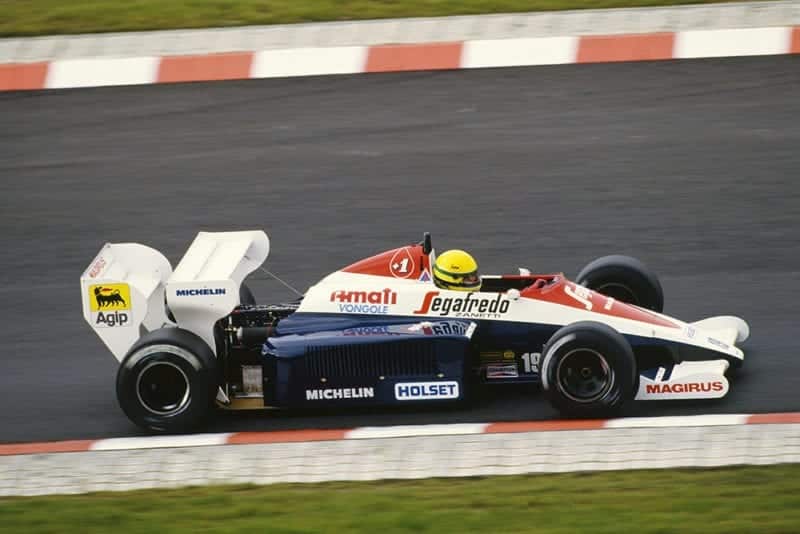
Ayrton Senna – returning for Toleman – qualified 12th
Motorsport Images
In accordance with the FIA Tribunal findings the Tyrrell team were absent, though Ken Tyrrell and one of his engineers were seen lurking round the paddock, and after the start-line fracas at Momara the boss of the ATS team had sacked Manfred Winkelhock and not replaced him. The Toleman team had re-instated Ayrton Senna, after slapping him on the wrist with suspension from the Italian Grand Prix, and he was back in car number 19, while the amiable Johansson was given car number 20, it’s rightful driver Johnny Cecotto still convalescing after his British Grand Prix practice crash. The Spirit team had Mauro Baldi back in their car, in place of Haub Rothengatter, which was all simply a question of money into the team’s meagre budget. As would be expected so near the end of the season, there was nothing startlingly new to see in the pit lane, though Renault had a new system of electronic fuel injection on the engine in Warwick’s car (RE 50/08), but it was not working very well, and he switched to the spare car. Ferrari only had three cars, all to the latest M2 specification, which was the McLaren-style rear end which appeared briefly in practice at Maim. Alboreto had 074, Arnoux 077 and the T-car they shared was 072. Brabham had a brand new car for Piquet, BT53/6 (although the identification plate has been in use on the Tear for some time!) and Williams had a new car for Laffite (FW0913/09). The.Ligier team had done a half-hearted “McLaren look-alike” to the rear end of one of their cars, calling it a JS23B and Toleman were back on their double-layer rear aerofoil for use on medium speed circuits, this modern Mickey-Mouse Motordrom having a projected lap speed of around 120 mph. Having done all their morning work in the dry, with the sun shining and the Eifel region on its best behaviour, the skies clouded over as the morning session finished and you could smell the rain on its way. This was timed neatly for 1 pm, just as the first qualifying session was due to begin, and as the first cars left the pit lane the first drops of rain began to fall.
The McLaren team were in a bit of a shambles, for during the morning Lauda’s car had been misbehaving and he was forced to use the T-car, and Proses car needed a lot of lunch-time work an it so that it was not ready as qualifying began. Needless to say the Brabham team was on the ball, and Piquet was one of the first out, putting in a very sharp lap as the rain-drops were descending. During the morning it had looked as though laps in the 1 min 20 sec bracket were going to be the order of the day, but Piquet re-wrote the standards with a quick one in I min 18.871 sec. While Piquet was doing this his little Italian team-mate Teo Fabi was kicking his heels, waiting for his car to be finished. By the time begot out on the track it was wet, as it was for Lauda and Prost and many of the others. By 1.30 pm all was quiet, the rain was drizzling down, the 1,000 or so spectators looked cold and lost in the huge concrete grandstands and there was not too much enthusiasm for Dent Natal Niirburgring. About 1.45 pm the drizzle stopped, the sun came out and there was a mad rush by those who had missed the first five minutes. Prost showed his remarkable talent by putting in a lap at 1 min 19.175 sec, amidst all the traffic and on a far from dry track, and Patrick Tambay did an equally impressive job with 1 min 19.499 sec, thus putting them second and third to Piquet, which was to turn out to be vital for their race prospects. Nobody else broke the 1 min 20 sec barrier. Lauda was plagued by a misfire on the engine in the McLaren T-car and Johansson never got a clean run in the second Toleman, nor in the third one, the Tear also misfiring and popping and banging. The rain came back in the night and when testing began on Saturday morning there
was still a lot of spray coming off the tyres, even though the sun was shining weakly. Having started off on wet-weather tyres and “wet” suspension and aerodynamic settings, it looked as though it was going to dry up, but by the time everything had been changed to “dry” the drizzle and gloom returned. See what I mean about being a Formula 1 engineer in charge of a car! By the time the afternoon qualifying hour arrived the rain was here tossup, so that the times recorded on Friday afternoon were going to stand for grid positions, but there were other problems.
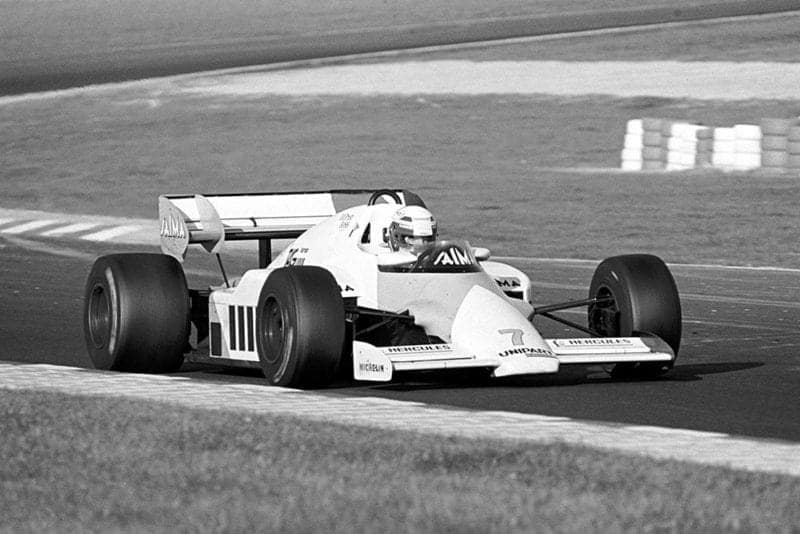
It was 2nd on the grid for Prost
Motorsport Images
If this weather was settled in for the week-end and the race was going to be run in typical Eifel conditions, there was the need to acquire some knowledge to suit the conditions. Consequently all except Laffite (no interest) and Tambay (no car) splashed round in the rain, many of them having mild excursions off onto the grass, including Frost, Alboreto and Piquet, but by the time the hour was finished most drivers had a pretty good idea of what they were in for on race day, unless the weather Gods relented. Elio de Angelis recorded the fastest time, some 20 sec slower than Piquet’s pole-position time, but even that was averaging just over 100 mph. Prost and Lauda knew what they were up to and covered 19 laps each in the hour, doing stints of seven or eight laps on the trot, to really get the feel of the new track in diabolical conditions. When it was all over the sun came out! By any standards testing and qualifying had been a shambles and the line-up for the start was far from normal, though it did offer some interesting situations, some of which were enhanced on Sunday morning during the half-hour warm-up period. The Eifel weather Gods having made their point on Saturday afternoon relented on Sunday and provided bright sunny weather, but a fairly low temperature, though not as low as that employed by the Williams team to their Mobil petrol in order to squeeze as much av possible into the fuel tank. The LEC refrigerator unit was recording minus 46 degrees Centigrade as the petrol passed through it. Some engineers were trying to arrive at a compromise for the conditions, while others with a surplus of material were
hedging their bets. Lauda had his regular car (MP4/2-1) set up for dry conditions and the T-car (MP4/2-3) set up for “wet” conditions, it being his turn at this event to have the spare car at his beck and call, the McLaren drivers alternating thus from race to race. Piquet had two Brabhams available to him as usual, and Warwick had opted for the spare Renault with the normal fuel injection, as the electronic set-up was not to his liking. After his troubled two days of practice Johansson was trying both his own car and the spare Toleman, settling to race the spare car, and Alboreto was going nicely and looking confident, which augured well with his place on the third row of the grid. Rounding the last corner, a fairly fast hairpin leading onto the Start u Ziel Plan, Prost got his left rear wheel over the edge of the track and promptly spun, heading for a wall of tyres. He missed these and hit a “Rescue Car” which was parked at the end of the tyre-wall instead of behind it. The car suffered badly and the McLaren got away with a broken rear wheel and upright, but the engine inhaled a lot of dirt.
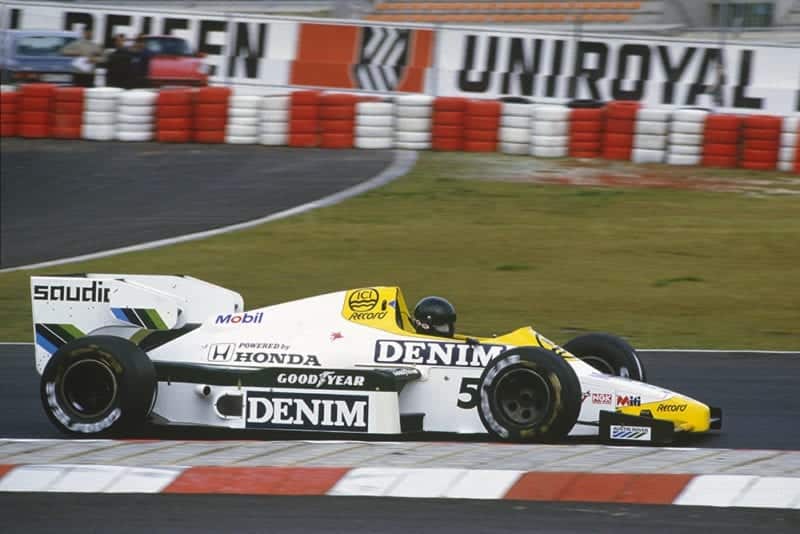
Jacques Laffite could only set the 14th fastest time for Williams
Motorsport Images
With Lauda staking his rightful claim to the spare McLaren there was nothing for it but for the hard-working McLaren mechanics to get stuck in and change the engine on Prost’s car and replace the damaged suspension parts. Fortunately there was no structural damage to the monocoque. Nobody really believed that the sunny day would last, so pre-race decision time was car of doubt and guesswork, but the sun did stay and the track was nice and dry, though the wind was cool, to say the least. As soon as the pit lane was opened Frost was out and away in his rebuilt car (MP4/2-2) with its replacement engine and he got in three laps before lining up on the durnmy-grid. As there had been a lot of guesswork by the engineers at least half the entry put in two laps, the system allowing this by making. a return to the pit lane, running down its length and out onto the circuit again. BY the time the pit lane was closed everyone was lined up on the dummy grid, waiting for the signal for Piquet to Lead them round on the parade lap to the starting-grid proper. With Piquet and Prost ‘at the front things looked normal, but with the two Ferraris on row 3 there was obviously something amiss. Lauda was on row 8 and de Angelis on row 12, both as a result of practice problems and the rain, and Johansson was in last place, whereas one can expect to see him somewhere near the top ten. These three were going to do some heroic carving through the field in the opening laps, of that we could be sure.
Race
A crowd estimated at 60,000 had turned up to watch this 67-lap European Grand Prix, and in a stadium built to accommodate 150,000 they were rattling about a bit in places, though the terrace opposite the pits and the start was well supported. Piquet led them round quietly, and in relation to their normal approach speed to the last corner they seemed to be crawling, but eventually all 26 cars wok up their places and an orderly start was given at 2.30 pm. Frost simply leapt away in a superb start and there was the sound of engines bouncing off the rev-limiters as they all charged down to the first corner, a clinical right-and-left run-bead called romantically “The Castrol-S”. Frost was in the lead from Tarnbay and Piquet as they headed down the slope to the Valvoline Corner and the Ford Corner before arriving at the Dunlop Hairpin.
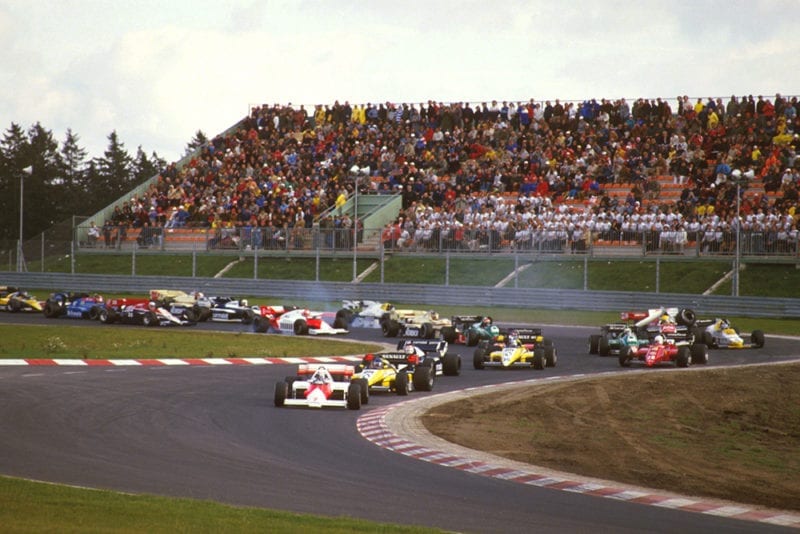
Prost leads as chaos begins to ensue behind
Motorsport Images
Meanwhile all hell had broken out behind them, for Rosberg had been slow off the mark and most of the nod-field runners had passed him before the Honda came on song. As he went into the first part of the Castrol-S he was alongside Senna’s Toleman, who had Cheever’s Alfa Romeo on his other side. It was all getting a bit tight and in moving left to avoid a collision with the Alfa the Toleman rode up and over the Williams-Honda, leaving a big tyre mark along the right side of the cockpit alongside Rosberg’s head! Naturally there was a lot of heavy braking and dodging about and taking to the grass, and when the dust settled Rosberg was out with a damaged right rear suspension, Senna was out was a bent rear end and only half a rear aerofoil, Surer was out with a bent Arrows, and Berger had gone off in the lone ATS and Ghinzani in his Osella also. Fabi was out on the grass on his own, but a rescue vehicle towed him back onto the track, where he re-started and joined in late. The other five cars had run their race. The order at the front was Prost, Tambay, Piquet, Warwick, Alboreto, Arnoux, Patrese, Cheever, Lauda. Boutsen, de Angelis, the two Ligiers and they Johansson. Apart from Fabi, Mansell was last, having avoided the fracas but lost a lot of time. It only needed a lap to see the pattern of things, Frost was waiting for no-one, least tel all his team-mate, Tomboy was comfortable in second place, hut l’iquet was a miserable third, his BMW engine
turned down for reliability rather than performance so that he had no hope of getting to grips with the leaders. Alboreto and Arnoux were lucky to be fifth and sixth, on their known standards, and the Alfas were equally lucky to be just behind them. Lauda was slicing his way past slower cars, losing no time in making up for his poor grid position, and de Angelis was doing likewise, while Mansell was using all the power the Renault engine could deliver to get back up near the front .where he belonged. It took Lauda a mere four and half laps to get his McLaren between the two Ferraris, but there his progress ended, for Alboreto was holding on to Warwick’s Renault nicely, no that there was not room for Lauda to pick them off one at a time.
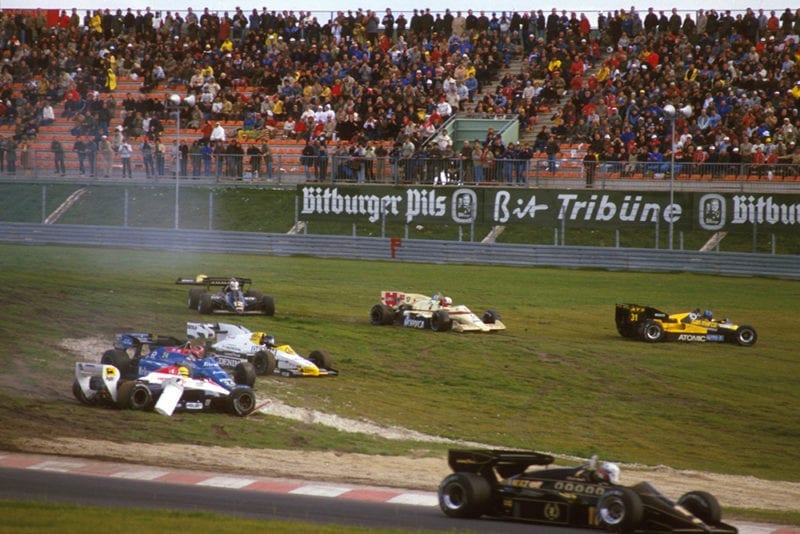
Cars are strewn everywhere but the track after a difficult negotiation of the first corner
Motorsport Images
He was going to have to pass the Ferrari and the Renault in one go, or stay behind them and it was soon apparent that he was staying behind them, being unsure of taking them together. Frost was pulling out a leisurely half a second a lap over Tambay and Piquet could only sit and watch the red and white car disappear into the distance, being barely able to keep up with the yellow and black French car. Boutsen made a pit stop with his BMW-powered Arrows for a change of tyres, which dropped him to the back of the depleted field and then Johansson stopped with his Hart engine overheating due to a loss of coolant. Frost droned on and on round the little Motordrom, a bare 2.8 miles to the lap, looking so smooth and confident that it was difficult to accept that there was a human being in the cockpit. You began to wonder whether Porsche had not arrived at the ultimate “black-box” to guide the McLaren round the computerised circuit. A study of the lap chart would show that the rest of the hour-and-a-half that Frost took to win the Europe. Grand Prix was not exactly filled with drama and excitement and the crowd could do little except sit or stand on the concrete embanlunents. There were no camp-fires or tents to return to on this new Islarburgrmg, or trees to climb, or forests to
wander through. just a concrete stadium with cars so far away that they lcoked like toys. Apart frorn Mansell working his way up to a creditable sixth place, there were no real changes other than when a car ran into trouble or stopped at the pits. At the end of lap 22 there was some excitement for those lucky enough tube in the vicinity, but it did not affect the lap chart. The trio of Warwick, Alboreto and Lauda had reached a situation of stalemate and were lapping the tail enders. As they came up the slope to the final hairpin they caught up with Baldi in the white Spirit and the first two nipped by under braking, leaving Lauda to either make a third into the closing gap, or hang back and follow Baldi round the corner. The Austrian made to follow through, realised in the nick of time he wasn’t going to make it and stood on the brakes. The McLaren spun in a cloud of tyre smoke and went off onto the grass on the outside of the corner. Brilliantly, Lauda kept the engine running and was able to drive back on the track and give chase again, without losing his place on the lap chart. However, de Angelis was now close behind the McLaren and Lauda’s Michelins had a flat spot on them which made things vibrate a bit, but did not visibly slow him down. In spite of stories saying that his flat-spotted tyres held him up, he went quicker and quicker according to the Longines / Olivetti time sheets. Before his spin he had been lapping in the mid-1 min 25 sec. By lap 29 he was down to 1 min 24.6 sec and reduced this to 1 mtn 23.9 sec by lap 43 and made his fastest lap in I min 23.729 sec on lap 48. Lauda was giving it all he’d got to make up for that error. One by one they began to drop out, de Angelis with a turbocharger failure, Laffite and Alliot likewise, Fabi with gearbox trouble, Mansell with a spectacular engine blow-up which spewed oil all over his rear tyres just as he braked for the last hairpin, which spun him smartly off onto the grass, Palmer with engine trouble, Gartner with a shortage of fuel and Cheever with plenty of fuel but no pressure from the pump. Both Renaults failed to last the distance, Tambay dropping back from a certain second place when his engine began to cut-out on left-hand bends. It became so chronic that he made a pit stop to see if anything could be done.
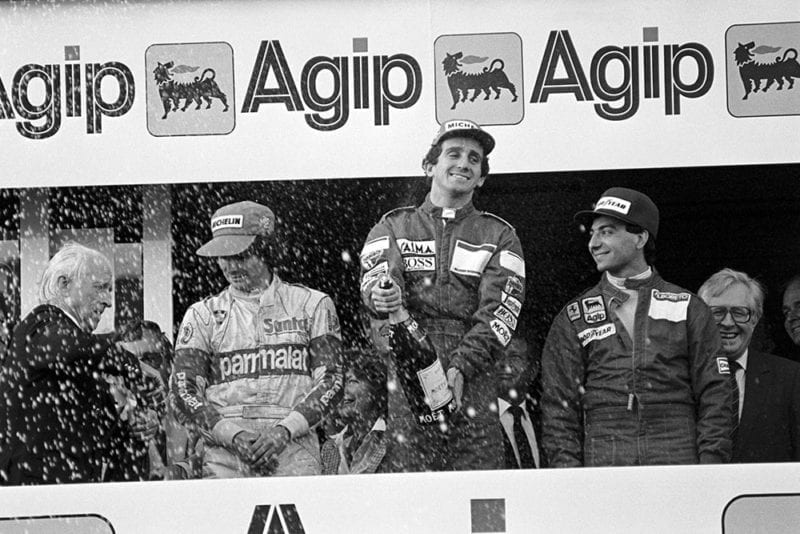
Prost lets fly with the winner’s beverage whilst Michele Alboreto (right) looks on in admiration; Nelson Piquet (Left) appears to have his mind on other matters
Motorsport Images
The ignition unit was changed and he tried once more, but this was not the trouble, and after two snore laps he packed it in. Warwick’s comfortable run in fourth place, which became third when Tambay slowed, evalwated when the left-hand exhaust system split, making a horrid noise and losing boost-pressure on that bank of cylinders. He struggled on as best he could but eventually the lop-sided power output was more than the engine could stand and it broke. This left Piquet pursued by Alboreto, in second and third places respectively, with Lauda fourth and the Ferrari driver was doing all he could to close the gap on the Brabham, but the little Brazilian had it all well under control. As Prost finished lap 67, waving both hands at the chequered flag in relief that everything had gone right for him for a change, Piquet and Alboreto were coming up the back leg of the circuit. Suddenly the BMW engine coughed and died, the fuel tank running dry, and the Ferrari surged by into second place, but as it rounded the last corner its engine also died through lack of fuel. The momentum carried it towards the finishing line and behind it Piquet was weaving the Brabham about to try and get the last dregs from the tank. The BMW gave one more burst of power which accelerated the Brabham up to the tail of the Ferrari and
then past it, but they were then both beyond the finishing line. Alboreto was second and Piquet third as they coasted to a stop at the end of the pits lane. At the same time Hesnault’s Ligier ran out of petrol and he also coasted to a stop. Luckily being three laps behind the winner so he only had to complete 64 laps.
A chastened Lauda arrived fourth, his McLaren-Porsche going as well as ever, and Proses McLaren-Porsche had run to perfection throughout the race, while the curly-haired little Frenchman had driven it to perfection to win his fifth race of the season and the 1 I th for McLaren International this year. — D.S.J.
